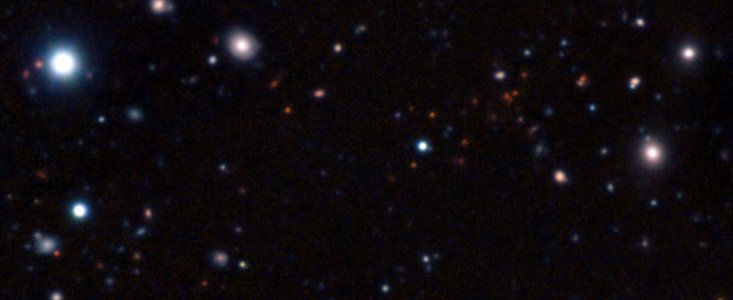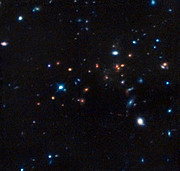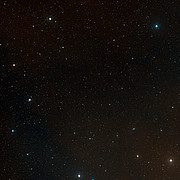Press Release
The Most Distant Mature Galaxy Cluster
Young, but surprisingly grown-up
9 March 2011
Astronomers have used an armada of telescopes on the ground and in space, including the Very Large Telescope at ESO’s Paranal Observatory in Chile to discover and measure the distance to the most remote mature cluster of galaxies yet found. Although this cluster is seen when the Universe was less than one quarter of its current age it looks surprisingly similar to galaxy clusters in the current Universe.
“We have measured the distance to the most distant mature cluster of galaxies ever found”, says the lead author of the study in which the observations from ESO’s VLT have been used, Raphael Gobat (CEA, Paris). “The surprising thing is that when we look closely at this galaxy cluster it doesn’t look young — many of the galaxies have settled down and don’t resemble the usual star-forming galaxies seen in the early Universe.”
Clusters of galaxies are the largest structures in the Universe that are held together by gravity. Astronomers expect these clusters to grow through time and hence that massive clusters would be rare in the early Universe. Although even more distant clusters have been seen, they appear to be young clusters in the process of formation and are not settled mature systems.
The international team of astronomers used the powerful VIMOS and FORS2 instruments on ESO’s Very Large Telescope (VLT) to measure the distances to some of the blobs in a curious patch of very faint red objects first observed with the Spitzer space telescope. This grouping, named CL J1449+0856 [1], had all the hallmarks of being a very remote cluster of galaxies [2]. The results showed that we are indeed seeing a galaxy cluster as it was when the Universe was about three billion years old — less than one quarter of its current age [3].
Once the team knew the distance to this very rare object they looked carefully at the component galaxies using both the NASA/ESA Hubble Space Telescope and ground-based telescopes, including the VLT. They found evidence suggesting that most of the galaxies in the cluster were not forming stars, but were composed of stars that were already about one billion years old. This makes the cluster a mature object, similar in mass to the Virgo Cluster, the nearest rich galaxy cluster to the Milky Way.
Further evidence that this is a mature cluster comes from observations of X-rays coming from CL J1449+0856 made with ESA’s XMM-Newton space observatory. The cluster is giving off X-rays that must be coming from a very hot cloud of tenuous gas filling the space between the galaxies and concentrated towards the centre of the cluster. This is another sign of a mature galaxy cluster, held firmly together by its own gravity, as very young clusters have not had time to trap hot gas in this way.
As Gobat concludes: “These new results support the idea that mature clusters existed when the Universe was less than one quarter of its current age. Such clusters are expected to be very rare according to current theory, and we have been very lucky to spot one. But if further observations find many more then this may mean that our understanding of the early Universe needs to be revised.”
Notes
[1] The strange name refers to the object’s position in the sky.
[2] The galaxies appear red in the picture partly because they are thought to be mainly composed of cool, red stars. In addition the expansion of the Universe since the light left these remote systems has increased the wavelength of the light further so that it is mostly seen as infrared radiation when it gets to Earth.
[3] The astronomers measured the distance to the cluster by splitting the light up into its component colours in a spectrograph. They then compared this spectrum with one of a similar object in the nearby Universe. This allowed them to measure the redshift of the remote galaxies — how much the Universe has expanded since the light left the galaxies. The redshift was found to be 2.07, which means that the cluster is seen about three billion years after the Big Bang.
More information
This research was presented in a paper, “A mature cluster with X-ray emission at z = 2.07”, by R. Gobat et al., published in the journal Astronomy & Astrophysics.
The team is composed of R. Gobat (Laboratoire AIM-Paris-Saclay, France), E. Daddi (AIM-Paris), M. Onodera (ETH Zürich, Switzerland), A. Finoguenov (Max-Planck-Institut für extraterrestrische Physik [MPE], Garching, Germany), A. Renzini (INAF–Osservatorio Astronomico di Padova), N. Arimoto (National Astronomical Observatory of Japan), R. Bouwens (Lick Observatory, Santa Cruz, USA), M. Brusa (MPE), R.-R. Chary (California Institute of Technology, USA), A. Cimatti (Università di Bologna, Italy), M. Dickinson (NOAO, Tucson, USA), X. Kong (University of Science and Technology of China), and M.Mignoli (INAF – Osservatorio Astronomico di Bologna, Italy).
ESO, the European Southern Observatory, is the foremost intergovernmental astronomy organisation in Europe and the world’s most productive astronomical observatory. It is supported by 15 countries: Austria, Belgium, Brazil, Czechia, Denmark, France, Finland, Germany, Italy, the Netherlands, Portugal, Spain, Sweden, Switzerland and the United Kingdom. ESO carries out an ambitious programme focused on the design, construction and operation of powerful ground-based observing facilities enabling astronomers to make important scientific discoveries. ESO also plays a leading role in promoting and organising cooperation in astronomical research. ESO operates three unique world-class observing sites in Chile: La Silla, Paranal and Chajnantor. At Paranal, ESO operates the Very Large Telescope, the world’s most advanced visible-light astronomical observatory and VISTA, the world’s largest survey telescope. ESO is the European partner of a revolutionary astronomical telescope ALMA, the largest astronomical project in existence. ESO is currently planning a 42-metre European Extremely Large optical/near-infrared Telescope, the E-ELT, which will become “the world’s biggest eye on the sky”.
Links
Contacts
Dr Raphael Gobat
Laboratoire AIM-Paris-Saclay, CEA/DSM-CNRS–Université Paris Diderot
Gif-sur-Yvette, France
Tel: +33 1 69 08 60 01
Email: raphael.gobat@cea.fr
Richard Hook
ESO, La Silla, Paranal, E-ELT and Survey Telescopes Public Information Officer
Garching bei München, Germany
Tel: +49 89 3200 6655
Email: rhook@eso.org
About the Release
| Release No.: | eso1108 |
| Name: | CL J1449+0856 |
| Type: | Milky Way : Galaxy : Grouping : Cluster |
| Facility: | Very Large Telescope |
| Instruments: | FORS2, VIMOS |
| Science data: | 2011A&A...526A.133G |
Our use of Cookies
We use cookies that are essential for accessing our websites and using our services. We also use cookies to analyse, measure and improve our websites’ performance, to enable content sharing via social media and to display media content hosted on third-party platforms.
ESO Cookies Policy
The European Organisation for Astronomical Research in the Southern Hemisphere (ESO) is the pre-eminent intergovernmental science and technology organisation in astronomy. It carries out an ambitious programme focused on the design, construction and operation of powerful ground-based observing facilities for astronomy.
This Cookies Policy is intended to provide clarity by outlining the cookies used on the ESO public websites, their functions, the options you have for controlling them, and the ways you can contact us for additional details.
What are cookies?
Cookies are small pieces of data stored on your device by websites you visit. They serve various purposes, such as remembering login credentials and preferences and enhance your browsing experience.
Categories of cookies we use
Essential cookies (always active): These cookies are strictly necessary for the proper functioning of our website. Without these cookies, the website cannot operate correctly, and certain services, such as logging in or accessing secure areas, may not be available; because they are essential for the website’s operation, they cannot be disabled.
Functional Cookies: These cookies enhance your browsing experience by enabling additional features and personalization, such as remembering your preferences and settings. While not strictly necessary for the website to function, they improve usability and convenience; these cookies are only placed if you provide your consent.
Analytics cookies: These cookies collect information about how visitors interact with our website, such as which pages are visited most often and how users navigate the site. This data helps us improve website performance, optimize content, and enhance the user experience; these cookies are only placed if you provide your consent. We use the following analytics cookies.
Matomo Cookies:
This website uses Matomo (formerly Piwik), an open source software which enables the statistical analysis of website visits. Matomo uses cookies (text files) which are saved on your computer and which allow us to analyze how you use our website. The website user information generated by the cookies will only be saved on the servers of our IT Department. We use this information to analyze www.eso.org visits and to prepare reports on website activities. These data will not be disclosed to third parties.
On behalf of ESO, Matomo will use this information for the purpose of evaluating your use of the website, compiling reports on website activity and providing other services relating to website activity and internet usage.
Matomo cookies settings:
Additional Third-party cookies on ESO websites: some of our pages display content from external providers, e.g. YouTube.
Such third-party services are outside of ESO control and may, at any time, change their terms of service, use of cookies, etc.
YouTube: Some videos on the ESO website are embedded from ESO’s official YouTube channel. We have enabled YouTube’s privacy-enhanced mode, meaning that no cookies are set unless the user actively clicks on the video to play it. Additionally, in this mode, YouTube does not store any personally identifiable cookie data for embedded video playbacks. For more details, please refer to YouTube’s embedding videos information page.
Cookies can also be classified based on the following elements.
Regarding the domain, there are:
- First-party cookies, set by the website you are currently visiting. They are stored by the same domain that you are browsing and are used to enhance your experience on that site;
- Third-party cookies, set by a domain other than the one you are currently visiting.
As for their duration, cookies can be:
- Browser-session cookies, which are deleted when the user closes the browser;
- Stored cookies, which stay on the user's device for a predetermined period of time.
How to manage cookies
Cookie settings: You can modify your cookie choices for the ESO webpages at any time by clicking on the link Cookie settings at the bottom of any page.
In your browser: If you wish to delete cookies or instruct your browser to delete or block cookies by default, please visit the help pages of your browser:
Please be aware that if you delete or decline cookies, certain functionalities of our website may be not be available and your browsing experience may be affected.
You can set most browsers to prevent any cookies being placed on your device, but you may then have to manually adjust some preferences every time you visit a site/page. And some services and functionalities may not work properly at all (e.g. profile logging-in, shop check out).
Updates to the ESO Cookies Policy
The ESO Cookies Policy may be subject to future updates, which will be made available on this page.
Additional information
For any queries related to cookies, please contact: pdprATesoDOTorg.
As ESO public webpages are managed by our Department of Communication, your questions will be dealt with the support of the said Department.




